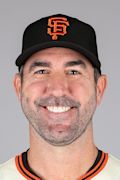| IP | 10.1 |
|---|---|
| ERA | 1.74 |
| WHIP | 1.06 |
| BB/9 | 3.48 |
| SO/9 | 9.58 |
- Full name Justin Brooks Verlander
- Born 02/20/1983 in Manakin-Sabot, VA
- Profile Ht.: 6'5" / Wt.: 235 / Bats: R / Throws: R
- School Old Dominion
- Debut 07/04/2005
-
Drafted in the 1st round (2nd overall) by the Detroit Tigers in 2004 (signed for $3,120,000).
View Draft Report
Verlander might have the best pure stuff in the draft, and looks like a good bet to go in the first three picks. Dozens of scouts, crosscheckers and scouting directors turned out in mid-April when Verlander faced off against Justin Orenduff, and Verlander was dominant as he punched out 16 batters and flashed consistent mid-90s heat. The dominance continued all spring, with a 7-5, 3.19 record and 145 strikeouts in 99 innings. He broke his own Old Dominion season strikeout record of 139, set last year, and his 421 (and counting) career strikeouts are a school and Colonial Athletic Association record. He has a lean, lanky frame with long arms and legs, and room for added strength. He has a tall, upright delivery with a lighting-quick arm, and a fastball that tops out at 99 mph with hard run and sink. He complements it with a curveball that has good late depth and sharp bite, and a deceptive changeup that has fastball arm speed and late fade and sink. Verlander's biggest obstacle is his lack of command. He rushes his body and lands on a stiff front side as he struggles to repeat his delivery.
Top Rankings
Organization Prospect Rankings
-
Verlander was considered a possible top-five-round talent out of high school, but his commitment to Old Dominion, strong grades and raw arm prompted him to pass through the 2001 draft untouched, much to his disappointment. He went to Old Dominion and became the No. 1 starter instantly. While his college career included several highs, such as pitching for Team USA in 2003 and setting school and Colonial Athletic Association strikeout records, he posted a modest 21-18 record and all three Monarchs teams he played for posted losing records. The Padres considered Verlander with the No. 1 overall pick in 2004 but he wasn't in their final trio of choices, leaving him available for the Tigers at No. 2. Negotiations broke off in October before his father stepped in, called the Tigers and got the contract settled. Verlander signed for a $3.12 million bonus and $4.5 million guaranteed major league contract. His late signing delayed his pro debut until 2005, when he was spectacular. Verlander led the minors in ERA (giving up only one run in 33 innings at Double-A Erie), started the Futures Game in Comerica Park and made his major league debut at Jacobs Field on Independence Day. Verlander has one of the best arms in the minors and features both the best fastball and curveball in the organization. Tall, lithe and athletic, he generates tremendous arm speed that gives him an electric fastball with both above-average velocity and life. His heater sits at 93-96 mph and touches 99. He commanded his fastball--and all of his pitches, for that matter--much better as a pro than he had in college. Most scouts had noticed that as an amateur, Verlander landed on a stiff front leg, cutting off his follow-through and leading to a tendency to leave his pitches up in the strike zone. The Tigers deemed this flaw correctable, but what impressed them most was how quickly Verlander took to his new delivery. He rarely if ever reverted to his old form. Verlander's curveball is a true knee-buckler, a power breaker with excellent depth and late bite down in the zone. He has excellent arm speed on his late-moving changeup, which also improved with his new delivery and ranks among the best in the organization. Stuff-wise, Verlander has no weaknesses. His changeup helped him shackle lefthanded hitters in the minors (.175 average, no homers in 171 at-bats). He didn't have that kind of success in his first two big league starts against the Indians and Twins, as lefties went 10-for-30 against him and drew four walks. The Tigers attribute much of that to nerves and inexperience, though. Verlander did recover from a three-run first inning in his first big league game to later retire 12 of 13 batters. As an amateur, he had the reputation of responding to adversity by trying to throw harder, and opponents thought he could be easily rattled. Neither was evident in his first pro season, however. The Tigers already have one power righty in their big league rotation in Jeremy Bonderman, who is just four months older than Verlander. He should join Bonderman full-time in the rotation in 2006, if not out of spring training then shortly thereafter. If Verlander learns the nuances of pitching to go with his electric stuff, he could supplant Bonderman as Detroit's No. 1 starter. -
Verlander had as electric an arm as anyone in the 2004 draft, though he went just 21-18 in three college seasons. The Tigers drafted him second overall, then broke off negotiations with him and his agent in October. Verlander's father jumpstarted the talks the following week, and Verlander signed a five-year big league contract with a $3.12 million bonus and $4.5 million guaranteed. Equipped with a lightning-quick arm, Verlander regularly pitches in the mid-90s and touched 99 mph several times during the spring of his junior year. His curveball is a knee-buckling hammer with vicious downward bite, and his changeup could give him a third plus pitch. The Tigers will have to make up for lost time and start reshaping Verlander's delivery when he reports to spring training. His command is affected by his upright finish and short stride, which causes him to leave too many pitches up in the zone. He doesn't use his changeup as much as he should. Verlander has the stuff to front a rotation, but scouts are divided on whether he profiles better as a closer. Detroit hopes he'll remain a starter and will begin his career in high Class A.
Minor League Top Prospects
-
FSL hitters simply couldn't catch up to Verlander's fastball, which sat at 94-95 mph and touched 98-99. He struck out more than a batter an inning in 10 of his 13 starts and never allowed three earned runs in a game. While many young fireballers are afraid to pitch inside, he had no worries about busting batters off the plate. Verlander only occasionally mixed in his curveball and changeup because there was very rarely a need to mess with success. His 12-6 curve gives him a second plus pitch, with tight spin and nice bite. His straight change projects as a potential plus pitch and he throws it with good arm speed, but he doesn't always command it as well. Command is Verlander's one remaining question, as managers described him as wild within the strike zone. While he didn't struggle with walks, he left the ball up in the zone too often, which would cause him problems in the majors.
Top 100 Rankings
Best Tools List
- Rated Best Curveball in the American League in 2012
- Rated Best Fastball in the American League in 2012
- Rated Best Pitcher in the American League in 2012
- Rated Best Curveball in the American League in 2011
- Rated Best Fastball in the American League in 2011
- Rated Best Pitcher in the American League in 2011
- Rated Best Curveball in the American League in 2010
- Rated Best Fastball in the American League in 2010
- Rated Best Curveball in the American League in 2009
- Rated Best Fastball in the American League in 2009
- Rated Best Fastball in the American League in 2007
- Rated Best Curveball in the Detroit Tigers in 2006
- Rated Best Fastball in the Detroit Tigers in 2006
- Rated Best Pitching Prospect in the Florida State League in 2005
- Rated Best Control in the Florida State League in 2005
- Rated Best Breaking Pitch in the Florida State League in 2005
- Rated Best Fastball in the Florida State League in 2005
- Rated Best Curveball in the Detroit Tigers in 2005
Career Transactions
-
Houston Astros activated RHP Justin Verlander from the 15-day injured list.
-
Houston Astros sent RHP Justin Verlander on a rehab assignment to Corpus Christi Hooks.
-
Houston Astros sent RHP Justin Verlander on a rehab assignment to Corpus Christi Hooks.
-
Houston Astros sent RHP Justin Verlander on a rehab assignment to Sugar Land Space Cowboys.
-
Houston Astros placed RHP Justin Verlander on the 15-day injured list. Right shoulder inflammation.
-
Houston Astros activated RHP Justin Verlander.
-
New York Mets traded RHP Justin Verlander to Houston Astros for OF Drew Gilbert and OF Ryan Clifford.
-
New York Mets traded RHP Justin Verlander to Houston Astros for OF Drew Gilbert and OF Ryan Clifford.
-
New York Mets activated RHP Justin Verlander from the 15-day injured list.
-
New York Mets sent RHP Justin Verlander on a rehab assignment to Binghamton Rumble Ponies.
-
New York Mets sent RHP Justin Verlander on a rehab assignment to Binghamton Rumble Ponies.
-
New York Mets placed RHP Justin Verlander on the 15-day injured list retroactive to March 28, 2023. Low grade teres major strain.

